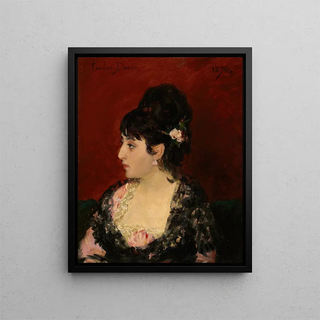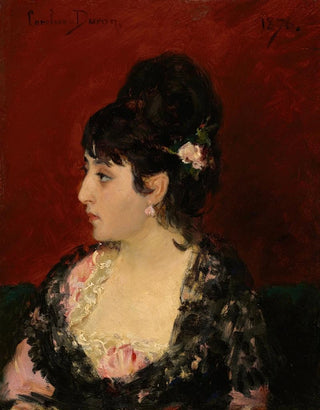Art print Femme espagnole - Carolus-Duran | Art print


View from behind

Frame (optional)
In the fascinating world of art history, some artworks manage to capture the essence of an era while transcending the boundaries of time. "Femme espagnole" by Carolus-Duran is a shining example. This painting, imbued with sensuality and mystery, invites the viewer to immerse themselves in a world where beauty and emotion meet. The artist, through this painting, succeeds in evoking a rich and vibrant atmosphere, where each brushstroke seems to whisper forgotten secrets. The woman depicted, both strong and delicate, embodies a duality that fascinates and attracts, and continues to enchant art lovers.
Style and uniqueness of the work
Carolus-Duran's style is distinguished by his ability to blend realism with a touch of romanticism. In "Femme espagnole," warm colors and subtly crafted lights create an intimate and captivating ambiance. The artist does not merely reproduce a face or silhouette; he manages to convey a palpable, almost tangible emotion. The pose of the woman, both natural and poised, reveals a complex personality, oscillating between reserve and confidence. Every detail, from the drape of her dress to the nuances of her complexion, testifies to exceptional craftsmanship and meticulous attention to the representation of feminine beauty. This work is not limited to a simple portrait; it becomes an ode to womanhood, to her strength and grace.
The artist and his influence
Carolus-Duran, whose real name is Charles Auguste Émile Durand, is an emblematic figure of the 19th century, straddling the crossroads between realism and impressionism. Trained at the École des Beaux-Arts in Paris, he quickly established himself as a renowned portraitist, attracting the attention of the elites of his time. His technique, marked by a keen sense of light and shadow, allows him to create works of rare emotional depth. Influenced by the masters of the past, he manages to infuse modernity into his subjects, rendering his art timeless. "Femme espagnole" is part of this lineage of

Matte finish

View from behind

Frame (optional)
In the fascinating world of art history, some artworks manage to capture the essence of an era while transcending the boundaries of time. "Femme espagnole" by Carolus-Duran is a shining example. This painting, imbued with sensuality and mystery, invites the viewer to immerse themselves in a world where beauty and emotion meet. The artist, through this painting, succeeds in evoking a rich and vibrant atmosphere, where each brushstroke seems to whisper forgotten secrets. The woman depicted, both strong and delicate, embodies a duality that fascinates and attracts, and continues to enchant art lovers.
Style and uniqueness of the work
Carolus-Duran's style is distinguished by his ability to blend realism with a touch of romanticism. In "Femme espagnole," warm colors and subtly crafted lights create an intimate and captivating ambiance. The artist does not merely reproduce a face or silhouette; he manages to convey a palpable, almost tangible emotion. The pose of the woman, both natural and poised, reveals a complex personality, oscillating between reserve and confidence. Every detail, from the drape of her dress to the nuances of her complexion, testifies to exceptional craftsmanship and meticulous attention to the representation of feminine beauty. This work is not limited to a simple portrait; it becomes an ode to womanhood, to her strength and grace.
The artist and his influence
Carolus-Duran, whose real name is Charles Auguste Émile Durand, is an emblematic figure of the 19th century, straddling the crossroads between realism and impressionism. Trained at the École des Beaux-Arts in Paris, he quickly established himself as a renowned portraitist, attracting the attention of the elites of his time. His technique, marked by a keen sense of light and shadow, allows him to create works of rare emotional depth. Influenced by the masters of the past, he manages to infuse modernity into his subjects, rendering his art timeless. "Femme espagnole" is part of this lineage of
12,34 €






